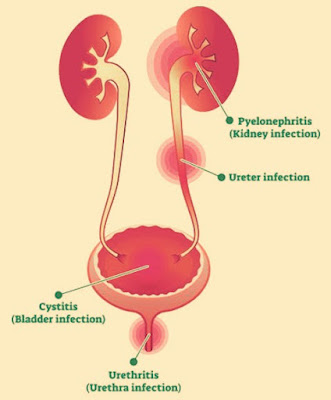What is Urinary Tract Infection?
An infection of the urinary system, which includes the kidneys, bladder, ureters, and urethra, is known as a urinary tract infection, or UTI. The likelihood of developing a urinary tract infection is higher in women. According to some experts, your lifetime risk of developing one is as high as 1 in 2, with many women experiencing recurrent infections, sometimes for years. In their lifetime, about one in ten men will develop a UTI.
Types Of UTI
Numerous locations along your urinary tract are susceptible to infection. Based on its location, each type has a unique name.
- Cystitis (bladder): You may experience frequent urination or discomfort when urinating. Along with lower stomach pain, you may also experience cloudy or bloody urine.
- Pyelonephritis (kidney): This can result in a fever, chills, nausea, vomiting, and pain in your upper back or side.
- Urethritis: This condition can make your urethra discharge and make it feel burning to urinate.
UTI signs and symptoms
A UTI may cause the following symptoms:
- A burning sensation after urinating.
- A strong urge to urinate often, even though it only produces a small amount of urine.
- Urine with a strange smell or that is cloudy, dark, or bloody.
- Experiencing fatigue or trembling.
- Fever or chills (a sign that the kidney infection may have spread to them).
- Pain or pressure in your lower abdomen or back.
UTIs' root causes
Doctors often advise women to wipe after using the restroom from front to back due to UTIs. The anus is close to the urethra, which transports urine from the bladder to the outside of the body. Large intestine bacteria, like E. coli, can cause illness. coli can occasionally exit the anus and enter the urethra. If the infection is left untreated, they may then proceed to infect your kidneys from the point where they first entered your body up to your bladder. Compared to men, women's urethras are shorter. This makes it simpler for bacteria to enter their bladders.
Additionally, having sex can spread bacteria through your urinary system. Because of their genes, some women are more likely to develop UTIs. Others are more vulnerable to infection due to the shape of their urinary tracts. Because of their impaired ability to fight off infections, women with diabetes may be more susceptible. Multiple sclerosis, hormonal changes, and illnesses that affect urine flow, such as kidney stones, strokes, and spinal cord injuries, are additional conditions that can increase your risk.
How to prevent UTI
You can prevent getting another UTI by heeding the advice below:
- As soon as you feel the urge to urinate, empty your bladder frequently; take your time and make sure you've completely finished.
- After using the restroom, wipe the seat from front to back.
- Drink a lot of water.
- Showers should be preferred to baths.
- Avoid scented douches, scented bath products, and feminine hygiene sprays because they will only make the irritation worse.
- Clean your genital region before having sex.
- Pee right away after sex to clear your urethra of any bacteria that may have gotten inside.
- If you currently use a diaphragm, non-lubricated condoms, or spermicidal jelly as a method of birth control, you might want to switch to another one. While unlubricated condoms and spermicides can irritate your urinary tract, diaphragms can accelerate the growth of bacteria. All of them increase the likelihood of UTI symptoms.
- Avoid moisture buildup in your genital region by dressing comfortably. Wearing nylon underwear and tight jeans can trap moisture, fostering the growth of bacteria.
UTI tests and diagnosis
Visit the doctor if you think you may have a urinary tract infection.

